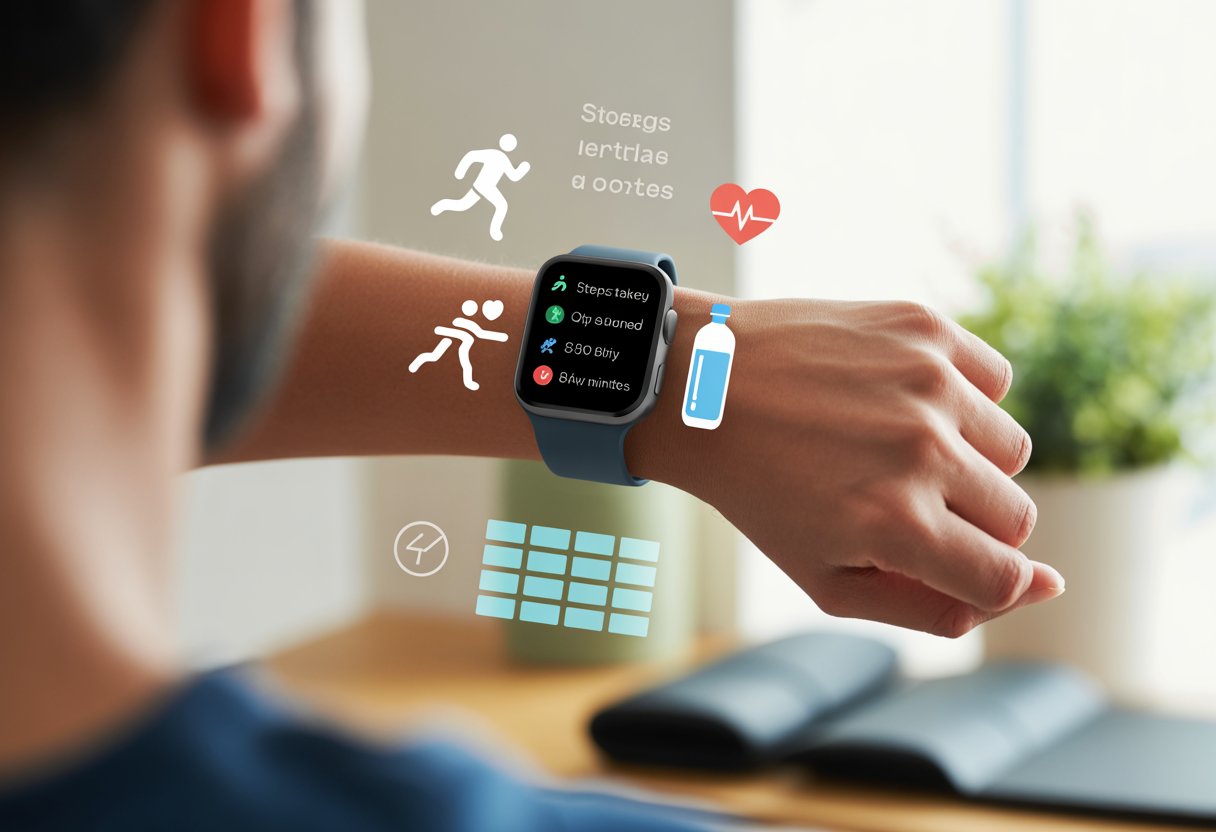Let’s be real—most of us could use a nudge to move more than just from the couch to the fridge. That’s where smartwatches come in. These little wrist coaches count our steps, buzz us to stand up, and sometimes even cheer when we walk out to grab the mail.
With a smartwatch, we track our daily activity goals, see progress in real time, and actually know if we’ve earned that extra snack.

Instead of guessing if we’re being active enough, our smartwatches just do the math. They count steps, log exercise minutes, estimate calories, and even remind us if we sit too long.
Some watches let us set goals—like 6,000 steps, 30 minutes of activity, or burning 300 calories a day. If we slack off, we’ll get a gentle buzz.
With all this tracking, hitting daily goals feels less like a chore and more like a game. If you want to make reaching your movement targets as easy as checking the time, stick around for some tips to help us train smarter and move more—thanks to our wrist sidekick.
Setting Up Your Smartwatch for Daily Goals
Before we conquer the world of daily activity, we need to make a few smart moves. Picking the best device, entering our personal details, and syncing with the right apps all play a part in helping us outpace the couch.
Choosing the Right Device
Let’s face it: not all smartwatches are created equal. Some of us go for the Tag Heuer Connected because it says, “I might jog, or I might just look good.”
Others grab a Garmin if we dream about mountain trails or, honestly, just want to survive a local hike.
If we have iPhones, the Apple Watch feels like the obvious pick—tech harmony is hard to beat. Of course, there are basic fitness trackers too, which do steps and sleep without much fuss.
What really matters? Comfort, battery life, and whether the watch does what we want. Do we need waterproofing because we swim—or just spill coffee a lot?
Features like built-in GPS, heart rate sensors, and auto-goal nudges help keep us motivated. It’s worth comparing a few before picking one that matches our lifestyle (and maybe our dog’s approval at the park).
Configuring Personal Details
Now it’s time to get personal. Entering weight, height, gender, and age helps the smartwatch calculate calories and heart rate zones better.
We grab our devices, type in the numbers, and let the algorithms handle the rest. If we’re tempted to fudge our age, honesty gets more accurate results—even if the truth is less fun.
The more our tracker knows about us, the better it can nudge us to move or suggest realistic goals. If the watch asks for units, double-check them.
Nothing’s more awkward than bragging about 10,000 steps when we’ve only made a few fridge trips.
Syncing With Wellness Apps
Now for the fun part: connecting our smartwatch to a wellness app. This sends our activity from the watch to our phone, so we can track trends, share wins, and—sometimes—stare at sad charts when life gets busy.
On the Tag Heuer Connected, we open the Wellness part of the app to review steps and activity data in style. With Apple Watch, syncing with Apple Health feels automatic. Garmin Connect works smoothly with Garmin watches.
Most wellness apps let us set reminders, check progress, and even challenge friends—perfect if we like a little friendly competition. When we sync up, everything feels smoother and our data stays backed up.
Lose your watch? No big deal—your stats survive. Plus, these apps let us tweak goals until they fit just right. Learn how to track your daily activity using Tag Heuer Connected or similar devices.
Understanding Daily Activity Metrics
Let’s admit it—half the reason we wear smartwatches is to feel good about moving around. Our wrists now track everything from steps to the calories we (supposedly) burn folding laundry.
Keeping tabs on these numbers helps us set real goals and figure out if we deserve another trip to the fridge… for water, obviously.
Explaining Step Counts and Step Goals
Step counts are the bread and butter of activity tracking. Our watch uses a pedometer—a fancy step counter—to add up how much we walk.
You’ll probably see a default goal of 10,000 steps, but don’t stress if we’re not hitting Olympic numbers. That target isn’t magic; it’s just a popular sign of being active.
We can set our own step goals to match what feels doable. Some folks shoot for 7,000 steps, others aim higher.
The best part? Our watch keeps track, so we don’t have to count steps in our heads (which never works anyway). Real-time tracking gives us reminders and those happy buzzes when we hit our goals, so it’s almost like a game.
Want more on step goals? Check out this Galaxy Watch discussion.
Calories and Active Calories Tracking
Watches estimate how many calories we burn while we move. There are two main types: total calories (everything we burn in a day) and active calories (the ones from exercise and activity, not just existing).
Smartwatches use heart rate and movement sensors to guess these numbers. It’s not perfect, but it gives us a rough idea.
Tracking these numbers helps us see if we’re burning more than we’re eating—or justifying that extra slice of pizza. We can check calories burned on the watch or in its app, usually with a simple chart.
If we want to dive deeper, we can focus on metrics that track calories burned for better detail. Watching our active calories can be super motivating if we’ve got fitness goals or just love seeing that “move ring” close before bed.
Tracking Exercise and Fitness Goals
Let’s be honest, we all secretly wish our smartwatches could turn us into fitness legends overnight. While they can’t lift weights for us (yet), they make it way easier to keep track of every step, squat, and sweat drop.
Logging Different Workouts
Our smartwatches act like personal cheerleaders—just with more buttons. Most watches can track all sorts of activities: running, walking, cycling, yoga, and even “chasing the bus because we overslept.”
We just pick the workout type, and our watch starts logging steps, minutes, calories, and heart rate. Some watches let us pick from over 100 sports, so whether we’re lifting weights or trying indoor rowing, there’s probably a setting.
If we care about the details, the watch shows stats like pace, distance, laps, and more. And honestly, our smartwatch doesn’t judge if our run is more of an enthusiastic stroll.
Thanks to reminders and smart notifications, we’re less likely to forget a workout. Curious about what activities smartwatches can track? Here’s a handy rundown.
Measuring Progress Toward Fitness Goals
Here’s where things get interesting. We can track our performance over time without a notebook (or photographic memory). Most smartwatches show simple charts for daily rings, weekly summaries, and calories burned.
We set specific fitness goals like 10,000 steps, burning a certain number of calories, or, let’s be real, not skipping leg day again. With every workout, we watch those numbers climb or get nudges to “move a little more.”
Active minutes, stand hours, and calorie counts keep us honest. And if we need a push, some apps let us compare stats with friends—because nothing motivates like a little friendly rivalry.
Want to see how smartwatches help us follow and adjust progress? Check out the Apple Watch daily activity tracking options.
Using Heart and Health Features
Smartwatches do more than count steps. They help us keep an eye on important health numbers and show us when we need a break or a boost.
Monitoring Heart Rate and Heart Health
We don’t usually think about our heart rate—unless the watch buzzes to say it’s way too high after running for the bus. Most smartwatches track our heart rate in real time, so we know what’s up whether we’re chilling or doing jumping jacks.
We can check our average resting heart rate every morning, kind of like seeing if we aced another night of sleep. Some watches even alert us if our pulse goes wild, acting like a nosy friend who cares a little too much.
Watching these numbers helps us see how fitness or stress affects our bodies. If we want to dig deeper, some watches show heart rate trends over time and help us spot patterns.
That makes it easier to notice changes and bring them up with a doctor if needed. Curious about healthy ranges or how smartwatches pull this off? There’s more in this guide on smartwatch health features.
Leveraging Body Battery and Active Time
Why keep guessing when we’ll crash after lunch? These days, smartwatches give us features like “body battery” that make things easier.
This tool adds up our rest, workouts, and stress to figure out how much energy we’ve got left. It’s a bit like a video game health bar, but with more yawning and less drama.
Active time helps us keep moving, even when the couch tries to win us over. Our watches send us friendly nudges (or, let’s be real, nags) when we’ve been still for too long.
Tracking active minutes each day makes sure we’re moving, whether we’re out power walking or just chasing a pet around the house.
Here’s a quick list of benefits:
- Body battery: Shows our current energy.
- Active time: Counts minutes when we’re actually moving.
Both features help us pay attention to our bodies and fit in more activity. They also make it easier to spot when we should rest.
If you want more details on tracking your activity, check out this smartwatch activity tracking article.
Smart Features for Activity Motivation
Smartwatches are definitely more than just step counters.
With a bit of planning, we can use built-in features to keep moving and stay on track—even when the couch looks pretty inviting.
Setting Alarms and Move Alerts
Honestly, we all need a push to move sometimes.
Smartwatches let us set alarms and reminders that buzz on our wrist when we’ve been sitting too long.
These move alerts act like a tiny coach, nudging us to stand up, stretch, or wander around. Sometimes it’s exactly what we need.
Most smartwatches offer different alarms. We can set wake-up alarms, hydration reminders, and timers for workouts with just a few taps.
Some watches even let us schedule hourly move alerts. Samsung Health and similar apps can ping us when it’s time to stop pretending we’re working and actually get up, helping us reach our daily goals using smartwatch alerts.
Some watches even track how often we ignore those reminders. We didn’t ask for that kind of judgment, but hey, it works.
Quick List of Useful Alerts:
- Hourly movement reminders
- Morning and bedtime alarms
- Water drinking reminders
- Custom exercise timers
Maintaining Accountability and Motivation
If the silent buzzing isn’t enough, smartwatches have other tricks to keep us honest.
We can check activity stats right on our wrist, set step targets, and maybe brag a little about our progress.
Seeing a nearly closed progress ring gives us just enough guilt to take a lap around the kitchen.
Many smartwatches offer goal tracking. We can check steps, active minutes, or calories burned, and adjust our goals as needed by tracking progress and sending notifications.
Some watches even toss up a tiny digital celebration when we hit our target. There’s nothing like confetti on a 1.5-inch screen.
We can also share our results with friends or join challenges. If your friend’s step count is just ahead of yours, you’ll probably want to catch up.
A little friendly competition keeps things interesting and helps us stick with it.
Personalizing Your Daily Goals
Getting the most out of a smartwatch means picking features that fit our actual lives—not just what Olympians do.
If we want to meet our daily goals and actually enjoy it, we’ve got to make the tech work for us.
Customizing Goals For Your Lifestyle
Let’s be honest—nobody wants a gadget telling them to run ten miles a day unless they signed up for a marathon by mistake.
Smartwatches let us set personal goals that actually fit our routines.
We can pick how many steps to hit, how long to move, or how many calories to burn. Some even let us set goals for distance or floors climbed.
If you don’t have time for gym selfies every day, smartwatches can remind you to stand or move—just enough to avoid turning into a permanent couch ornament.
Apple Watch, for example, lets us set “Move,” “Exercise,” and “Stand” goals, so we can track what matters to us.
If you use wheelchair mode, the watch switches to pushes instead of steps so everyone can join in.
Want to know more about goal options? Here’s a list:
- Steps (walking, running, wheelchair pushes)
- Calories burned
- Minutes active
- Standing time
- Distance covered
Adapting Features for Specific Needs
We all have different needs. Some of us climb stairs at work, while others just pace the kitchen, counting down the seconds on the microwave.
Smartwatches keep up, surprisingly well. You can tweak notifications, set reminders, or turn on wheelchair mode if you need it.
That way, your daily goals stay within reach, no matter your routine or ability.
If you’re training for something—maybe a 5K, or maybe just trying to survive Monday—you can adjust your trackers for specific workouts.
Some watches let you set up custom screens that show what actually matters: heart rate, active minutes, or just the distance left to the couch.
Pair your watch’s activity tracking with reminders you set, and suddenly you’ve got a personal coach. Thankfully, there’s no yelling involved.
Need ideas for customizing? Try these:
- Change goal types based on your activity level
- Enable wheelchair mode for accurate tracking (details here)
- Customize notifications for those friendly nudges
- Add quick access to your favorite workout data (read more)
- How to Use a Smartwatch for Daily Activity Goals Without Becoming a Cyborg - November 10, 2025
- Fitness Tracker Error Code 21 Fix: Why Your Steps Don’t Count Toward World Domination - November 9, 2025
- Best Smartwatches for Teenagers: Because Your Wrist Deserves Better Than a Friendship Bracelet - November 9, 2025






